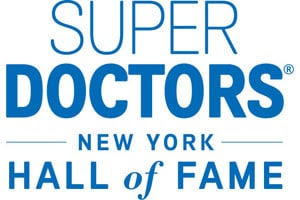Trigeminal Neuralgia/Hemifacial Spasm
What is a Trigeminal Neuralgia/Hemifacial Spasm?
Trigeminal neuralgia and hemifacial spasm are cranial nerve disorders in which the trigeminal nerve and the facial nerve are compressed as they exit from the brainstem.
There are 12 pairs of cranial nerves that emerge from the brain and brainstem. Each of these nerves is responsible for different sensations and controlling different organs of your body.
The trigeminal nerve is the 5th cranial nerve that branches to provide sensation to different parts of the face including the eyes, cheek, and jaw. Trigeminal neuralgia causes pain in these regions of the face when the trigeminal nerve is compressed by a blood vessel. On rare occasions, the trigeminal nerve may be compressed due to a tumor in the brain. Patients with trigeminal neuralgia experience episodes of severe facial pain, which can be triggered by talking, chewing, touching the face, and other tactile stimuli.
The 7th cranial nerve is the nerve that controls the facial muscles. Hemifacial spasm is characterized by involuntary and intermittent twitching or spasms of the facial muscles on one side of the face. The underlying cause of this condition is abnormal compression of the facial nerve by a blood vessel. Patients with this condition usually notice an intermittent twitching of the eyelid muscle at first, which may slowly progress to pulling the eye shut. As the condition worsens, patients may notice contractions in the lower facial muscles, which may result in the mouth being pulled to one side. If the condition is left untreated, it may eventually affect all the muscles on one side of the face.
Symptoms of Trigeminal Neuralgia/Hemifacial Spasm
Some of the symptoms of trigeminal neuralgia/hemifacial spasm include:
- Intermittent facial pain
- Tics or twitching sensation
- Irritation or discomfort
- Constant aching or burning sensation
- Tingling or numbness
- Facial deformity
- Ptosis or drooping eyes
- Impaired balance or vertigo
- Tinnitus (less commonly)
Causes of Trigeminal Neuralgia/Hemifacial Spasm
Some of the causes of trigeminal neuralgia/hemifacial spasm include:
- Swollen blood vessel pressing the nerve
- Benign tumor or lesion compressing the nerve
- Multiple sclerosis, a disorder that damages the protective covering of the nerves
- Damage to the nerve as a result of an injury, surgery, or infection
- Family history
- Vascular malformation
- Other medical conditions affecting the trigeminal/facial nerve
Diagnosis of Trigeminal Neuralgia/Hemifacial Spasm
Diagnosis will depend upon the location and type of the pain and elements that trigger the pain. Your physician will first carefully review your medical history and perform a thorough neurological exam to determine which section of the trigeminal/facial nerve is being affected. He will touch different sections of your face to establish the exact site of the pain. Specific tests will be ordered to rule out other neurological conditions, such as postherpetic neuralgia or cluster headaches which exhibit similar symptoms. An MRI scan may be recommended to help exclude other conditions such as multiple sclerosis, arteriovenous malformation, aneurysm, or a brain tumor that may be causing trigeminal/facial nerve compression. Electromyography (EMG) and nerve conduction velocity (NCV) tests may also be ordered to evaluate the muscle and nerve electrical activity in the facial region.
Treatment for Trigeminal Neuralgia/Hemifacial Spasm
Treatment for trigeminal neuralgia/hemifacial spasm involves non-surgical as well as surgical methods, such as:
- Medications: These are employed as the first-line of treatment and can provide pain relief and decrease the number of attacks. Your physician typically uses anticonvulsant drugs, such as phenytoin (Dilantin) or carbamazepine (Tegretol), which are medications that block nerve firing. Some other second-line or adjunctive medications in the form of muscle relaxants, such as baclofen (Lioresal) and diazepam (Valium) and tricyclic antidepressants, such as Desipramine (Norpramin) and Nortriptyline (Pamelor) may also be prescribed.
- Glycerol/Botox injections: During this procedure, you will be administered local anesthesia and a syringe containing glycerol/Botox is injected into the treatment area under fluoroscopic (live X-ray) guidance. Once the shot is delivered, the medicine blocks the nerve’s ability to transmit pain signals and provides significant comfort. Your physician may deliver 1 to 3 injections in a sitting and the effect of the injections may last for about 3 months.
- Stereotactic Radiosurgery: The SRS procedure involves using three-dimensional computerized imaging to locate and precisely deliver a high-concentrated dose of radiation to the root of the nerve in a single session with minimal impact on the surrounding healthy tissue. This is a painless procedure and is normally performed without anesthesia.
- Radiofrequency Thermal Lesioning: This is a minimally invasive surgical procedure that uses high-frequency radio waves to heat electrodes which contact the specific nerve causing the problem until a lesion is created at the contact point. These lesions block the nerve from transferring the pain signal to the brain.
- Gamma-Knife Radiosurgery: This is a minimally-invasive outpatient procedure in which high-dose radiation is delivered in a targeted approach to damage the problematic trigeminal/facial nerve to reduce or eliminate pain. The procedure is highly popular due to its effectiveness, precision, and a high degree of safety compared to other surgical methods and is the least invasive alternative.
- Microvascular Decompression: One of the most effective treatments for neurovascular compression syndromes such as trigeminal neuralgia and hemifacial spasm is microvascular decompression surgery. This surgery entails separating the compressing blood vessel away from the affected cranial nerve. This is a minimally invasive surgical technique where the affected nerve is decompressed through a very small incision located just behind the ear.


